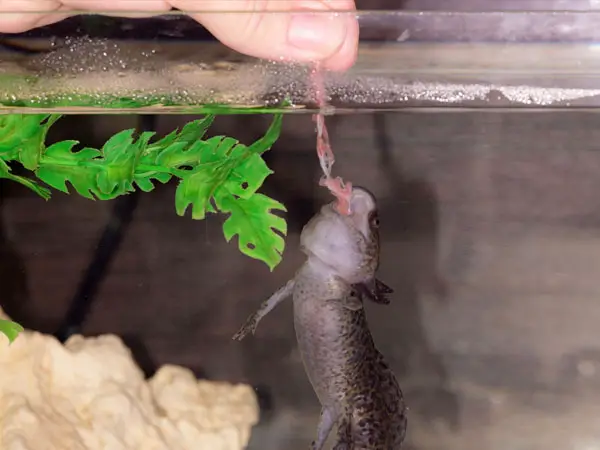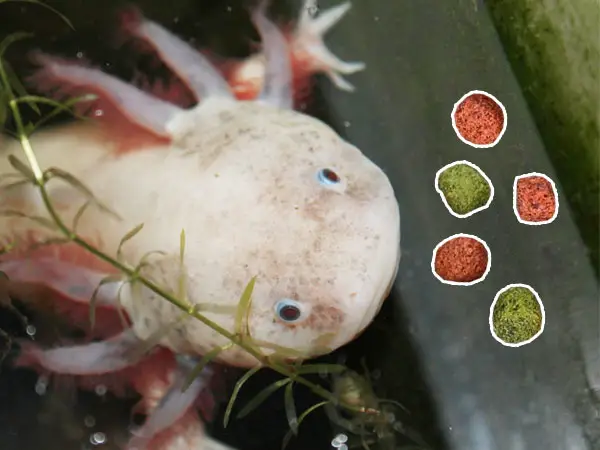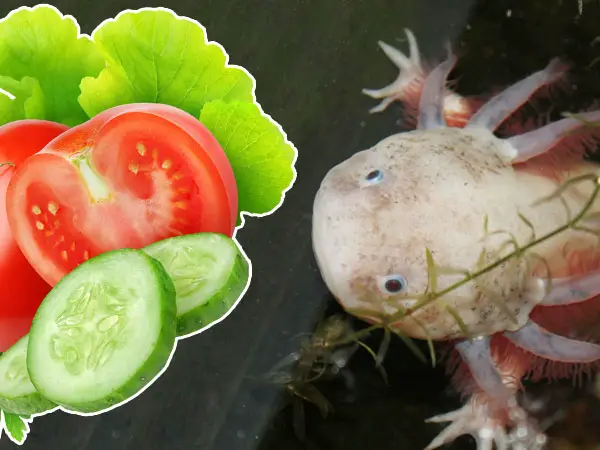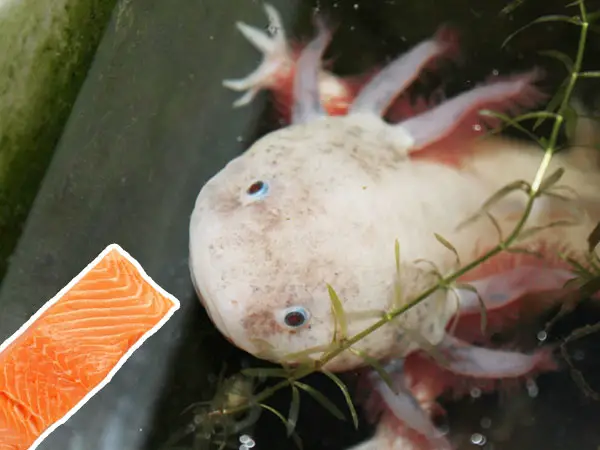One of the most important things when keeping a pet is feeding it a healthy diet. And for a diet to be healthy, it needs to be species-appropriate and nutrient-dense. What does that mean for axolotls? Keep reading to find out!

In this article, I’ll discuss the five best foods for axolotls and some foods you should never feed your pet. I’ve included foods that are appropriate for both baby and adult axolotls, as well as staple foods and occasional tasty treats. So, let’s get right into it!
Best Food Types for Axolotls
Ideally, you want to closely replicate your axolotl’s natural diet, even in captivity. You should include some of the same foods they’d eat in the wild, including various invertebrates and other small aquatic animals. Below, I’ll give you a list of the most commonly-available options you can buy in stores. This list includes live, frozen, freeze-dried, and other miscellaneous foods.
– Live Food
Live foods are among the best to feed to your axolotl. Live food is always fresh and has the most nutrition of all food categories. Furthermore, live food has the perfect ratios of protein, fat, and moisture content. It’s ideal for creating a balanced and species-appropriate diet for your pet. And let’s not forget— axolotls are carnivorous, so they’re natural predators and skilled hunters.
Including live foods will help simulate their natural feeding conditions, so it also counts as enrichment. Since they naturally consume live food they hunt in the wild, axolotls will love this type of fare. You also have many options to choose from, which lets you create a diverse regimen for your pet. Some of the most commonly available foods include:
— Earthworms
Also known as “Lumbricus terrestris” or “nightcrawlers,” these are a go-to for many salamander owners. Axolotls love this food, and earthworms are also nutritious and widely available. These worms are rich in protein and minerals, have a moderate amount of carbohydrates, and are rather low in fat. It’s the perfect combo, which makes them a suitable dietary staple.
You can find live earthworms in most pet stores. Typically, you can get a pack of 12 earthworms for around $5, which should last for one to two weeks. Earthworms are quite large, so they’re best suited for adult axolotls. If you’re feeding juveniles, it’s best to section the worms accordingly.
— Blackworms
Blackworms, also known as “mudworms,” can make a nice delicacy for your pet. They belong to the same genus as the humble earthworm but are a different species. Scientifically named “Lumbriculus variegatus,” the blackworm is shorter than the average earthworm, reaching a length of 2.4-4.0 inches at most.
Blackworms are also touted as being highly nutritious and adored by even the pickiest eaters. This worm is the perfect choice if you’re struggling to find food for a fussy axolotl or you’re looking for smaller feed for your juveniles. However, know that these worms are a bit messy. If you plan to make these a staple in your pet’s diet, expect frequent cleaning.
— Bloodworms
Bloodworms (also known as Chironomid Midge larvae) are very popular with fish, reptile, and salamander owners. These worms are small and suitable for both adult and juvenile axolotls. You can find live bloodworms in most pet stores and online for an affordable price.
They make an excellent nutritional treat, and axolotls love the taste of these. Bloodworms have a good protein content, although they contain less than other popular live foods. They’re high in fiber, low in fat, and rich in minerals (especially iron).
Despite their good nutritional content, these shouldn’t make up a large part of your pet’s diet. Bloodworms don’t contain all the amino acids that axolotls need. Relying too much on bloodworms can lead to deficiencies.
— Red Wrigglers
Red Wrigglers (Eisenia fetida) are part of the same family as the common earthworm. They look similar, but Red Wrigglers are roughly half the size and have a rich red color. Like other worms, Red Wrigglers are rich in protein and minerals, particularly iron and zinc.
These worms contain 20 amino acids, which make them a good source of complete protein for your axolotl. Red Wrigglers also have a good ratio of fatty acids, containing monosaturated and polyunsaturated fats. They make a suitable staple, and you can find them in most local pet stores for an affordable price.
I should note, though, that Red Wrigglers are an acquired taste. Also nicknamed “manure worms,” Red Wrigglers emit a foul smell and have a putrid taste. Unsurprisingly, many axolotls hate this food. But some do gladly eat it! It’s worth giving this feed a try if you want to diversify your pet’s diet.
— Daphnia
Live daphnia are cheap and easily accessible in most aquarium stores. Daphnia, a type of small crustacean, makes an excellent feed for small axolotls. These organisms grow up to 0.24 inches at most and are soft-shelled. The size and texture make them easy to eat and digest, even for very young hatchlings.
Daphnia are rich in protein, low in carbohydrates, and have a good amount of fat and fiber. They provide an excellent amount of vitamins, especially vitamin A, B-vitamins, and vitamin D. All these nutrients are crucial for proper growth and bone health.
Because it’s a food with high digestibility, young axolotls can absorb over 90% of the nutrition within it. The only disadvantage is that this food is not suitable for adults. Your mature axolotls would have to eat a lot of Daphnia to get enough energy. But even so, you can still feed it as a snack, on top of more energy-dense foods like worms.
— Brine Shrimp
Brine Shrimp is another cheap, widely available food best suited for baby axolotls. They grow up to 0.4 inches in length and are soft and easy to bite into. They’re not as nutritious as other foods, though. They contain less protein and are higher in fat than other live foods.
As such, brine shrimp feed is best for growing axolotls that can consume more energy and fat. It’s also wise to supplement brine shrimp with other nutrient-rich foods. I should also mention that brine shrimp can become messy. These animals die quickly when exposed to fresh water, so you’ll get a lot of dead leftover shrimp during feeding.
– Sinking Pellets
Sinking pellets are the second-best staple food for axolotls. They aren’t as exciting as live foods, but they have other pros going for them. First of all, pellets are very cheap, and there are various products to choose from. They’re easy to find in pet stores, you can buy them in bulk, and they store well for months.
Pellets are the perfect size for baby and adult axolotls alike. They’re easy to measure and portion. Plus, nutritional information is readily available on product labels. A quality product will contain a lot of protein, sufficient fatty acids and fiber, and even some added vitamins and minerals, especially vitamins A, D3, and calcium.
They’re specially designed to work as a dietary staple, so your axolotl can easily meet their nutritional needs by consuming pellets. Most pellets contain a combination of shrimp, salmon, halibut, squid, herring, and other omega-3-rich fish.
– Freeze Dried Food
Freeze-dried foods are a suitable substitute if you can’t find quality live food. This food doesn’t have as much nutrition but can make a good meal or snack when supplemented with other feeds like pellets. Freeze-dried food also has some undeniable advantages.
Freeze-dried food doesn’t carry the same risk of contamination as live food, as parasites and bacteria are killed during the drying process. This food has a very low moisture content, so it stores well for long periods.
The long shelf life makes this feed easy to find and buy in bulk from most pet stores. You’ll discover many options, including freeze-dried bloodworms, brine shrimp, Mysis shrimp, tubifex, daphnia, copepods, and more. Just know that you’ll have to soak the food before feeding your axolotls.
– Frozen Food
Frozen food is another accessible alternative to live food. It makes a good nutritious addition to other staples like pellets. It has virtually the same advantages as dried food. It’s cheap, readily available, and stores very well.
Frozen food generally comes in small cubes, so it’s already portioned for you. No need to measure anything! However, you will need some planning when feeding your axolotls frozen food. You need to thaw the cubes first, which might take 20-30 minutes. So, you might want to start prepping earlier than the set feeding time.
The most popular options include frozen bloodworms and frozen brine shrimp. Your axolotls will love the frozen alternative as much as the fresh option. Frozen food might have less nutrition than fresh, but it still offers a good amount of protein and fatty acids.
– Shrimp & Small Fish
Salamanders consume small fish and shrimp in the wild. Thus, your pet will be instinctively attracted to these foods. After all, axolotls are notorious for preying on other fish in the tank. This goes to prove their appetite for anything that moves.
Fish and shrimp can make good food sources for adult axolotls, but they’re not very popular staples. If you wish to include fish and shrimp in your pet’s diet, I recommend you stick to only two species:
— Ghost Shrimp
Ghost shrimp are small and delicate critters. They grow up to 1.5 inches at most and have translucent bodies. Their size and peaceful temperament make them a safe food source for axolotls. Unlikely to fight back, Ghost Shrimp pose no threat to your pet.
They pack decent nutrition, including protein, omega-3 and omega-6 fatty acids, B-vitamins, vitamins D and E, and crucial minerals like zinc. Unlike other shrimp species, Ghost Shrimp have a soft exoskeleton, which makes them easy to bite and digest.
As a bonus, Ghost Shrimp are also very helpful in the aquarium because they help you get rid of detritus, dead plants, algae, and uneaten food. So, why aren’t they more popular if they’re so good? There are a few reasons for this.
Ghost Shrimp are expensive if you plan to use them as feed. They generally cost $0.6-$3 per piece. Breeding them yourself will also take at least two months (one month for hatchlings, two months for full-grown adults).
Ghost Shrimp also pose a high risk for contamination, especially if store-bought. You’ll have to quarantine the shrimp for at least 30 days before feeding your axolotl. Otherwise, you risk transmitting bacterial or parasitic infections to your pet.
— Guppies
The ideal feeder fish for axolotls should be small, nutritious, and unlikely to carry parasites or harmful bacteria. Guppies are perhaps the only species that meets all these requirements. These fish grow up to 1.4-2.4 inches and are known for their hardy nature.
They’re unlikely to carry any disease. However, like Ghost Shrimp, you must quarantine them for at least 30 days to ensure safety for your axolotls. As for the nutritional profile, Guppies contain a good amount of protein and sufficient fat, especially omega-3 fatty acids. They have plenty of vitamin D and zinc as well.
The average Guppy costs $2.99-$3.99 apiece. You’ll have to pay $16.99 for a group of six. If you plan to breed feeder Guppies at home, it will take 3-4 weeks to get new fry and up to 6 months for the fry to become adults.
Foods Axolotls Shouldn’t Eat
Axolotls are voracious carnivores. They’ll try to eat anything meaty, as long as it’s small enough. Despite their flexible eating habits, you’ll have to be selective about what you feed them. Certain foods, although tasty and nutritious, might pose a threat to your pet’s health. Here are some things axolotls shouldn’t eat:
– Foods With a Hard Exoskeleton
Axolotls have very small and dull teeth that aren’t made for chewing. Axolotls only use these rudimentary teeth to bite into the food, which they then swallow whole. This is why you shouldn’t feed them hard-shelled live foods like most shrimp (krill, bamboo shrimp, red cherry shrimp, crystal shrimp, etc.) and mealworms.
Two things can happen if your axolotl consumes such foods. First, the hard exoskeleton might damage your axolotl’s teeth. This could cause pain and make grabbing and biting into food more difficult. Secondly, chitin-rich foods like shrimp and mealworms are hard to digest and can cause digestive issues and constipation in your pet.
– Feeder Fish
Common feeder fish include guppies, platies, goldfish, mosquito fish, rosy red minnows, and fry fish of most species. Feeder fish can be a unique and nutritious addition to your axolotl’s diet. Still, most people don’t recommend this feeding practice for various reasons.
Parasitic, fungal, and bacterial infections are very common in the aquarium hobby. Thus, using fish as feed poses a serious threat of life-threatening food-borne illness. You can, of course, mitigate this issue by quarantining feeder fish before feeding.
But besides infection risk, feeder fish are not a suitable dietary staple. Fish contain adequate protein, fat, and minerals but don’t have enough B vitamins. An over-reliance on fish could lead to nutritional deficiencies. If you want to include fish in your pet’s diet, you must ensure feed safety and overall nutrient adequacy in the diet.
– Preserved and Processed Meat
Some people occasionally feed their axolotls lean pieces of beef or chicken. While this is not a natural food for axolotls, it works as a rare treat. But some meats you should keep away from your salamander pet. Axolotls should, under no circumstance, consume processed or cured meats.
Processed meat includes things like salami, sausage, hotdog, ham, and other deli meats. Cured and processed meats contain many harmful compounds, including added fat, artificial flavorings, nitrites, and nitrates. This food is so bad for humans that it’s classified as a Group 1 carcinogen. Imagine what it can do to your pet’s health!
Conclusion
Axolotls are carnivorous animals with a varied diet. They consume many small invertebrates and small aquatic animals. You can’t go wrong including some of their naturally-preferred foods in their diet.
Live foods make a good staple, as they’re protein-rich and highly nutritious. This includes things like earthworms, blackworms, bloodworms, red wrigglers, daphnia, and brine shrimp. Sinking pellets are a good alternative if you can’t find live foods in your area. They’re cheap, nutritionally complete, and beloved by most axolotls.
Other things you can include in your pet’s diet are freeze-dried foods (bloodworms, brine shrimp, tubifex, daphnia, etc.), frozen foods (bloodworms, brine shrimp), ghost shrimp, and maybe Guppies. Some foods you should absolutely avoid are hard-shelled animals (most shrimp, mealworms), processed meats, and non-quarantined feeder fish.




